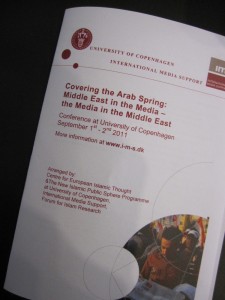Presentation: Media and Intranational Cascading Effects: The Egyptian Revolution’s Cairo-Alexandria Interdependency, by Amro Ali.
Conference: Covering the Arab Spring
Date: 1-2 September 2011
Venue: University of Copenhagen
Slide One: Introduction
There has been much discussion on digitally enabled cascading effects, or domino effects, across national boundaries in the Arab spring. But internal cascading is not often given the same amount of attention, despite it being a critical component to the relationship between the media and the masses.
During the course of the past couple of months, I undertook weekly travels between Cairo and Alexandra to study the dynamics and mechanics of the social movements in both cities. On the Friday 27 of May this year, I was observing the mass demonstrations in Alexandria, what was dubbed the second revolution. One of the lead protesters took out his smart phone to check the progress of demonstrations in Cairo, and announced to the crowds that our brothers in Cairo have reached a million. The implication being that Alexandria can beat that. The Alexandria protests got bolder, the chants got louder, the marches got stronger.
Slide Two: The City behind the city
In mid-July, protesters from Tahrir Square went to Alexandria, the Lotus Revolution Coalition representative Ahmed Bahgat addressed the Alexandrian protesters, saying, “It is a great honor to be here in Alexandria, from which came the first martyr, Khaled Saeed…Your sit-in here gives us protesters in Cairo the motivation to continue our sit-in as you lend us emotional support. If you disperse, we cannot continue, as we draw our strength from you.”
Now at first glance, this might come across as self-serving rhetoric employed by revolutionaries to safeguard a national consensus and momentum, but Bahgat’s statement is not without some considerable merit. The images here highlight a sense of urban identity that matters to Alexandrians.
With the exception of the intensity of the 18 days of the revolution, Alexandria before and after the event, has provided much of the narratives and myths, while Cairo has provided the power backing.
In my months of research between the two cities, I have attempt to document how and why one city is influenced by the other. The relationship between Egyptian cities are complex and mixed, but the ones that do have a sizeable impact are the gravity centres of Cairo and Alexandria. They both shared passions, envies, hopes, and stereotypes. All when channelled through the social media sphere, distorts the picture by fomenting an amplification of the other city’s situation.
In the course of the revolution and despite the many deaths of protesters in Alexandria, the coastal city’s inhabitants largely reacted more vehemently to coverage of events in Cairo’s Tahrir Square than to events in their own local vicinity. In post-Mubarak Egypt, protests in Alexandria have been partially fuelled by the social media-enabled perception that Cairo is receiving better reforms than Alexandria. In turn, Cairo’s protests are further encouraged by the sight of protesters in Alexandria, therefore giving the impression of a national movement that has yet to lose momentum.
Now many Egyptians will tell you that the revolution was about overthrowing tyranny. Yet the road taken was heavily dependent on how Egyptians perceived each other in who will first crack the status quo.
Slide Three – Cascading Effects
It would be misplaced to say the Egyptian masses reacted to corruption, abuses, and rising food prices alone. In oppressive regimes, there will be a mismatch between what someone believes in private and what they say in public. There is considerable evidence to show that Egyptians reacted when the relationship between their private beliefs and public lies were no longer sustainable, and a perception of a fracture in the status quo enabled the galvanisation of cascading effects, this by far and large, could be seen to be the modus operandi of the Arab Spring.
In the book, Private Truths, Public Lies: The Social Consequences of Preference Falsification, Timur Kuran explains the consequences of expressing support for an opinion that isn’t one’s actual belief, or making a choice against one’s actual desire. He calls it preference falsification:
“Where the status quo owes its stability to preference falsification, there are people waiting for an opportunity, and perhaps others who can easily be induced, to stand up for change. Some eye-opening event or an apparent shift in social pressures may cause public opposition to swell. The public preferences of individuals are interdependent, so a jump in public opposition may be self-augmenting. Under the right conditions, every jump will galvanize further jumps.”
In the 1940 classic novel, The Heart is a Lonely Wonder. One underlying message that comes from the reading is that people see what they want to see, and in the era of digital cameras, satellite TV, and the rapid transmission of images, they are given plenty to see and act upon.
Slide Four: The Three Interdependency Links
I want to underline three factors that underpin cascading effects in the Cairo-Alexandria interdependency: Social media in identity formation, narrative formation, the relationship between socio-geographic factors and media.
Revolutionary events in Cairo and Alexandria fomented a mutual cascading effect between both cities, amplified by satellite TV and social media, which helped to break down each other’s sense of isolation. The Arab Spring within Egypt illustrated that protest movements in its major urban centres were galvanised by each other’s images and discourse, leading to a spiral of civil disobedience in which one city attempted to, inadvertently, outdo the other.
Before that, what matters is how both cities perceive the other.
Slide Five: Perceptions Shape Reality
Cairo perceptions of Alexandria: Often a romanticised view of the coastal city that is associated with escapism, summer, sea, and vacation.
Compared to other Egyptian urban centres, Alexandria is given a higher number positive stereotypes such as “Bride of the Mediterranean” and the “courageous people”. Egypt’s popular arts and regional soft power has helped engender Alexandria with this generous image.
Alexandrian Perceptions of Cairo: A mixture of awe, envy and resentment. Cairo is referred to as Masr (Egypt). Kind of like calling the city of Ahrus refering to Copenhagen as Denmark.
Alexandrians tend to have a slightly less favourable view of the Caironese. Much of this resentment arises from the capital city’s centralisation of power and job opportunities. The most common complaint Alexandrians make is the traffic problems caused by Cairo holiday goers in Alexandria’s summer. Recently, it has manifested in a grudge of Cairo taking credit for the Egyptian revolution which Alexandrians believe started in their city.
Now not too much should be read into this, they are not so serious so as to prevent marriage and trade between the two cities. But what it does do is provide a contextual backdrop as to why cascading effects and media interplays with each other.
Slide Six: How much is a picture worth?
Cascading effects is being driven by what Egyptians are seeing on satellite TV and social media. So someone tearing down a poster of Mubarak, will witness the massive tearing down of posters all over the country. The Battle of the Camel in Tahrir Square, led many Alexandrians to protest in the streets over the Tahrir Square thuggery. And we are seeing the bandwagon effect even after the revolution.
Jonathan Jones from the Guardian puts it like this:
“It is impossible to overstate the visual and spectacular nature of revolution. From the first time a crowd surges into a public square to the last cannonade, revolutions live and die by the image. A revolution is a moment when politics becomes ecstatic, symbolic, and existential. The usual slow routines of news and debate suddenly speed up, and the fastest form of communication is the visual image. The first phase of the Egyptian revolution began with the image of that great people’s gathering on Tahrir Square; the second has begun with pictures of a fallen tyrant.”
Slide Seven: De-friending the Status-Quo
To understand the significance of the social space in Egypt is to understand the weight of social media in Egypt. The traditional social space for a hyper-social society like Egypt’s was the coffeehouse, but over the past decade internet cafes grew as a rival. Some places physically merged the two, where you could smoke sheesha and surf the net. Six years ago, social networking sites like Friendster, Myspace and the aging mIRC were the popular choice.
In 2004, there was an estimated 250 social protests, most dealing with rising food prices. A watershed moment came when the movement Kafeya (Enough) burst onto the scene, in which they demanded that Mubarak had ruled long enough and it was time for him to go. It was an exciting prospect, but my observation was that it seemed limited to university students who were out of touch with Egypt’s masses. Social media had not fully matured to the level that could facilitate an effective form of civic activism. Yet over the years, with the rise of social media tools, there began an experimentation with these fabled applications as a form of civic protest. Egyptian youth started utilising Facebook, Twitter, as a way, for example, to create flash protests and decoy protests.
Social media in the Egyptian revolution and beyond fashioned a decentralised horizontal resistance movement pitting it against security forces that only understood hierarchical structures which they then took that onto the streets and looked for the same sort of structure in the protest movements.
Yet activists actively hunt for a unifying symbol, just like the black civil rights movement actively sought out Rosa Parks who could legitimise the struggle in 1955, the Egyptian activists found their Rosa Parks.
Slide Eight: Constructing the myth of Khaled Saeed
In this context, Khalid Saeed was born. Khaled Saeed is the 28 year old Alexandrian who died at the hands of police last year on the 6 of June and was the inspirational face of the Egyptian Revolution. Now Khaled was my neighbour in the suburb of Cleopatra Hamamat. His death undoubtedly affected all our friends. Yet no one on our street was prepared for what was to come: His mythologization.
So why Khaled Saeed and not the countless others who suffered at the hands of the regime? Well let’s look at the most commonly repeated version of his death: a young man enters an Internet cafe to upload an expose video of crooked police sharing the spoils of drugs to YouTube. He was then beaten by the police and died at the Internet café. Here you have a powerful figure that can now encapsulate the young generation: young, social media savvy, and anti-authoritarian, and he was martyred at an internet cafe. This is the young and wired Egypt! On top of that, his name is given to one of the largest activist Facebook groups: “We Are all Khaled Saeed”.
Now the version I just narrated of Khaled’s death I find it at odds with primary sources I looked into, but it has been seized by the pro-democracy movements and human rights activists and reported as factual in the world’s respectable mainstream press. Yet whatever is said, it will not matter. A marriage of youth activism and social media had given birth to a poster child. Khaled Saeed’s myth was set in stone.
Had Khaled died in prison, or in the slums or if the exact same circumstances of Khaled Saeed’s death took place in a different part of Egypt such Luxor or Sohag, the chances of Khalid rising to prominence post-mortem would be doubtful. Yet with the backdrop of an innocuous Alexandria, Khaled’s youthfulness, middle class tech saviness, catapulted Khaled to prominence.
Khaled Saeed was rapidly adopted by Cairo based social media groups, and the further you go away from Khaled’s Saeed’s neighbourhood, his larger than life image grows. Alexandria had in effect laid the foundational myths of the Revolution and set the tone for change
Slide Nine: Writing the social media narrative
The notion of Thawrat Al-Shabab (youth revolution) has nurtured a discourse that has transformed social media into their defining hallmark. In Egypt, the deification of Facebook, Twitter, Youtube and other tools has cultivated a self-perpetuating belief and bandwagon effect that such tools are instrumental to enacting positive change, and hence the more people will use such technologies despite not having placed much importance on them before. Moreover, online identities become intricately linked to the Revolution. For example, it is not uncommon for the youth to change their birthdays on Facebook to 25January 2011 (The start date of the Revolution).
Like Bahgat’s statement, in Cairo, it’s not uncommon for the Tahrir protesters to tell you they are inspired by Alexandria. When you press them for a concrete answer, they might say that it’s the place that Khalid Saeed died or Alexandrians are always going out there and protesting. None of which are satisfactory answers.
Revolutionary and social media artwork tends to be more commonplace in Alexandria than Cairo, and this could lend clues as to the sources of inspiration, and the answer I believe is partially the outcome of Alexandria’s socio-geographic layout.
Slide Ten: The Socio-Geographic Perfect Storm
What makes Alexandria’s situation peculiar is the close proximity of the protest epicentre, university campuses, and the Library of Alexandria which serves as a venue and hub of intellectual debates and special events. Such a close proximity enables charged up youths to unleash a creative energy into the nearby social movements. The campus is what I call the stronghold of the digital youth The University of Alexandria has its faculties spread out across the city. Yet the ones that would have the most politically charged up students happened to be coincidently placed closer to the epicentre of activism: The faculty of arts, law and commerce. This triangular zone becomes a sort of incubator for the revolution’s creative angle.
Slide Eleven: The Alexandrian Long March
Yet protest activity will translate into long marches that crosses 11 suburbs. Starting at the Qaed Ibrahim courtyard, they will march through the major roads of the city. Alexandria’s protests are what I call take away revolution. Where unlike Cairo, you need to go to Tahrir to witness demonstrations, in Alexandria, the revolution comes to your doorstep. Literally.
Slide Twelve:
The implication is that a large swathe of people is exposed to political activism that they may not otherwise have joined. Also, the protests foment a bandwagon effect, in which people viewing from their balconies would come down to join the protest. The most common chants heard in the streets, “Come down oh Egyptians”. Yet the numbers coming out into their balconies translates into a multiplier effect causes another phenomenon.
Slide Thirteen: The initiation point of Social Media: The Camera
I lost count with the number of Alexandrians who took out cameras to photograph the marches. The outcome is that Alexandria’s social media angle is inserting a disproportionately a high number of images and commentaries into cyberspace that is sustaining the post-revolutionary activities. Of course this does not mean everyone snapping a photo with their camera phone is going to upload it to social media tools. Yet the probability increases dramatically.
Slide Fourteen: Scripting the Alexandria Playbook
The number of images is one matter, but there also comes a story with Alexandria’s protest styles, which I have yet to confirm to what extent it is planned. At every point in the protest movement, you’ll come across scenes in which stories are told.
I wish to add that the linear movement of the city’s roads and transportation system enables the youths to move from one part of the city to the other side at relatively low cost and on a predictable route. Hence the youth are not only able to organise on social networking sites, but to also spread their activities, especially protest style marches, through a large swathe of the city’s cornice. Whereas Cairo, with its distant, costly, hazardous criss-cross network of roads, often only sees its protests limited to Tahrir Square.
Slide Fifteen: Tahrir Square
Now the role of Tahrir Square and Cairo plays a paramount importance, there is much credibility to the saying that he who controls Tahrir, controls Cairo, and he who controls Cairo, controls Egypt. Mubarak would not have cared as much if the protesters had taken over the Pyramids.
Tahrir Square does not have the same coincidence of design, it has the AUC, but that cannot be said to be representative of Egypt’s mainstream youth. Yet Tahrir’s layout makes up for it with intensity and symbolism. The centralisation of protest movements enables an intensification of human movement, crowd issues, and notably, the media spectacle it provides.
The international media spotlight on Tahrir Square has given the square legitimacy in Arab eyes, during the Revolution, Tahrir Square galvanised Alexandrians in which many attempted to reach Cairo only for the regime to cut all rail links to the capital.
Although some Alexandrians can argue with some justification that the seeds of the revolution started in Alexandria, the revolution could not have been accomplished without the entry of Cairo.
More often than not, we have seen a dependency in which one city depends on the other for myth building and narrative construction, and the other depends on it for power and shaking up of the system. It is for this reason that Cairo is what I call an actor without a script, and Alexandria is a script without an actor. There are exceptions, the city of Suez played a big part in the initial stages of the revolution, images of torching the premises of the NDP party, police stations and murals of regime figures, galvanised much of Egypt. Suez is what I call the mouse that roared.
Slide Fifteen: Implications
The implications are broad and require a redefining of social networks, and measuring the alignment of popular sentiments between urban centres in the wired world. The question should not just be how did the Egyptians view the Tunisians, although that is important, but how are they viewing each other. How do perceptions of the other in affect perceptions when revolutionary activities are speeded up.
The other factor is that social media needs to be recognised as social networks like any other. It should not matter if social mobilisation happens to be a face to face meeting over a shisha in a coffee house, a phone text message, or wall post. Phillip Howard, from the University of Washington, notes this to be a false dichotomy that to describe face to face meetings as strong ties and text messages as weak ties. Images of protesters being beaten up alone were enough to bring people into the streets, or Wael Ghonim crying on TV was enough to give the uprising a new lease of life.
Following the fall of the Tunisian dictator, and before the fall of Mubarak. Many specialists went on record saying that Mubarak will not befall the same fate as Tunisia. Specialists need to reframe their paradigms so as to be more accommodating of digital media and its relationship to collective identities, shared grievances, and, ultimately, perceptions that provoke cascading effects.
There are questions that remain to be answered?
If social media plays a role in narrative formation from Alexandria’s end, what does this mean for groups like the Muslim brotherhood who have their strongholds in Alexandria, or the Coptic Christians, in which the coastal city holds historical significance as the seat of their faith and hence the title of Pope of Alexandria.
Does Cairo’s population volatility make it difficult to measure public opinion due to the millions who travel daily to and from the capital city, could this make it susceptible to Alexandria’s constant factors.
Finally, does Tahrir’s intense circular style of protesting versus Alexandria’s forward linear style affect how social media interprets developments and how images are ported through the media sphere.?
These issues need further study into the future. I thank you for your time.






